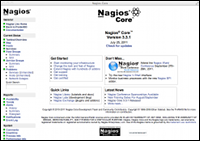Bug in Nagios 3.3.1
Bug: Nagios fails to send plugin data to external grapher software if the plugin is not providing the extra perfdata output. As a result, the performance/capacity graphing for these plugins is failing. Workaround is to enable perfdata plugin output, if possible. However, a number of plugins does not provide perfdata and rewriting them in a short time is not feasable. For those of us relying the graphing, I advise to hold off on the upgrade until it is fixed. For customer installations and support, this bug is critical.
References:
Introduction

Here I am describing examplary the procedures to update a production Nagios system once a new version of Nagios has been released. This typically happens not so often and allows for long periods of productivity using a particular version of Nagios. It also means that it is easy to forget all the steps required to upgrade Nagios safely and ensuring a smooth transition, avoiding impact on the active production monitoring. With the recently released Nagios version 3.3.1, I'll take the time to document and walk through the steps.
===
This how-to is still being refined. It needs to be simplified, and the steps need to be re-ordered for a better, logical approach.
===
System Background
Nagios is easily customizable. While this is a good thing, it adds a challenge to upgrading. It is wise to keep a balance between additional features versus the effort of keeping components integrated and up to date. So far, my personal preference for a particular Nagios design emerged over a few years of running Nagios:
- Compilation from Nagios source, rather then using OS-provided packages. This allows me to upgrade Nagios or the OS independently whenever required, and to keep Nagios in a dedicated filesystem.
- Using a agentless, SNMP based monitoring method wherever possible. This requires many custom add-on plugins, which we need to keep track of. These need to be tested and redeployed with each new version of Nagios.
- From the list of Nagios add-ons that enhance its functionality, the graphing package Nagiosgraph is used to visualize monitoring data and trends. Graphical configuration GUI's did not improve our efficiency and Business visualization packages like Nagvis ior BPI are nice, but the management overhead is substantial
Version 3.3.1 - Whats New
With the new version 3.3.1 released - is it worth upgrading, and how fast?

Most visible is the updated Web GUI design. While the overall layout is unchanged, Matt Wall's Exfoliation theme provides a more attractive styling and improves the general look and feel.
The Nagios main splash page now shows information boxes that contain a mix of more or less useful news and product links. Depending on the browser and window size, these info boxes tend to be inconsistently formatted and look out of shape (IE-8). I'll probably take them out.
A handful of other minor enhancements, none requiring a update in configuration files.
A number of bugfixes (18), including two security issues:
- XSS vulnerability in config.cgi and statusmap.cgi
- unauthorized contacts could issue hostgroup and servicegroup commands
Overall, the bugfixes (security) and GUI enhancements make it worthwhile to plan the upgrade.
Upgrade Process
To keep the upgrade process manageable, I divided it into the following 3 areas:
Click Next to start reading about "Upgrade Preparations", click on a work area in the list above or simply follow the sidebar links to jump directly into a subsection of the upgrade procedure.